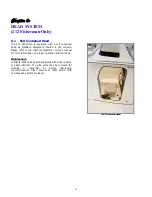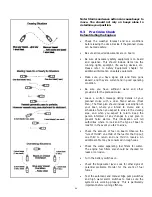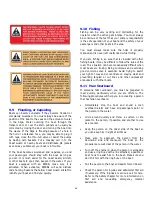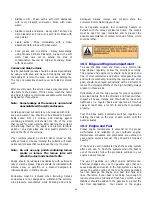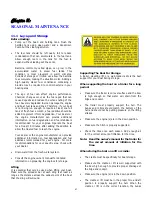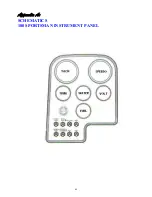
Releasing the Anchor
Release the anchor by driving the boat slowly to the
point where the anchor line becomes vertical. It should
release when you pass that point. If the anchor doesn't
release right away, stop the boat directly above the
anchor and tie the line to the cleat as tight as possible.
The up and down movement of the boat will usually
loosen the anchor within a minute. Make sure you
secure the anchor and properly stow the line before
operating the boat.
9.6 Controls,
Steering,
or
Propulsion System Failure:
If the propulsion, control or steering system fails while
you are operating the boat, bring both throttles to idle
and shift to neutral. Decide whether you need to put out
the anchor to prevent the boat from drifting or to hold
the bow into the seas. Investigate and correct the
problem if you can. Turn the engine(s) off before going
into the engine compartment to make repairs. If you are
unable to correct the problem, call for help.
If only one engine has failed, you can usually run home
on the other engine. Be careful not to apply too much
power to the engine that is running. When only one
engine is used to power a twin engine boat, that engine
is over propped and can be overloaded if too much
throttle is applied. You should contact your dealer or the
engine manufacturer for the maximum power settings
when running on one engine.
9.7 Collision
If your boat is involved in a collision with another boat,
dock, piling or a sandbar, your first priority is to check
your passengers for injuries and administer first aid if
necessary. Once your passengers situations are
stabilized, thoroughly inspect the boat for damage.
Check below decks for leaks and the control systems for
proper operation. Plug all leaks or make the necessary
repairs to the control systems before proceeding slowly
and carefully to port. Request assistance if necessary.
Haul the boat and make a thorough inspection of the
hull and running gear for damage.
9.8 Grounding, Towing and
Rendering Assistance
The law requires the owner or operator of a vessel to
render assistance to any individual or vessel in distress,
as long as his vessel is not endangered in the process.
If the boat should become disabled, or if another craft
that is disabled requires assistance, great care must be
taken. The stress applied to a boat during towing may
become excessive. Excessive stress can damage the
structure of the boat and create a safety hazard for
those aboard.
Freeing a grounded vessel, or towing a boat that is
disabled, requires specialized equipment and knowledge.
Line failure and structural damage caused by improper
towing have resulted in fatal injuries. Because of this,
we strongly suggest that these activities be left to those
who have the equipment and knowledge, e.g., the U.S.
Coast Guard or a commercial towing company, to safely
accomplish the towing task.
48
Summary of Contents for 180 Sportsman
Page 2: ...2...
Page 4: ...4...
Page 7: ...180 FISHERMAN SPECIFICATIONS 7...
Page 8: ...180 SPORTSMAN SPECIFICATIONS 8...
Page 9: ...202 FISHERMAN SPECIFICATIONS 9...
Page 10: ...212 FISHERMAN SPECIFICATIONS 10...
Page 18: ...18...
Page 39: ...SAFETY LABELS 2601 1124 39...
Page 40: ...180 FISHERMAN 180 SPORTSMAN CAPACITY LABELS 40...
Page 41: ...202 212 FISHERMAN CAPACITY LABELS 41...
Page 61: ...Appendix A SCHEMATICS 180 FISHERMAN INSTRUMENT PANEL 61...
Page 62: ...Appendix A SCHEMATICS 180 SPORTSMAN INSTRUMENT PANEL 62...
Page 63: ...Appendix A SCHEMATICS 202 212 FISHERMAN INSTRUMENT PANEL 63...
Page 68: ...Appendix A SCHEMATICS 180 FISHERMAN 180 SPORTSMAN TRAILER DRAWING 68...
Page 69: ...Appendix A SCHEMATICS 202 212 FISHERMAN TRAILER DRAWING 69...
Page 70: ...Appendix A SCHEMATICS 180 FISHERMAN OVERHEAD LAYOUT 70...
Page 71: ...Appendix A SCHEMATICS 180 SPORTSMAN OVERHEAD LAYOUT 71...
Page 72: ...Appendix A SCHEMATICS 202 FISHERMAN OVERHEAD LAYOUT 72...
Page 73: ...Appendix A SCHEMATICS 212 FISHERMAN OVERHEAD LAYOUT 73...
Page 77: ...MAINTENANCE LOG 77...
Page 78: ...MAINTENANCE LOG 78...
Page 80: ...Appendix D BOAT ACCIDENT REPORT 80...
Page 81: ...81...
Page 87: ...Appendix F TROUBLESHOOTING GUIDE 87...
Page 88: ...TROUBLESHOOTING GUIDE 88...
Page 89: ...TROUBLESHOOTING GUIDE 89...
Page 90: ...TROUBLESHOOTING GUIDE 90...
Page 91: ...TROUBLESHOOTING GUIDE 91...

